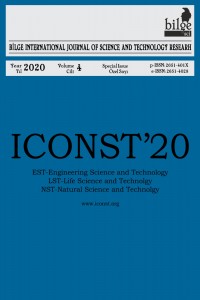Abstract
References
- Saneinejad, S. & Roorda, M. (2009). Application of sequence alignment methods in clustering and analysis of routine weekly activity schedules, Transportation Letters, 1:3, 197-211, DOI: 10.3328/TL.2009.01.03.197-211.
- Jain, U., Singh, M., Rishiraj, Verma, R., Vijay, R. & Rastogi, R. (2019). Revision of PV2 based pedestrian crossing warrants in India using clustering techniques, Transportation Letters, 11:5, 241-249, DOI: 10.1080/19427867.2017.1415122.
- Guadalupe Arredondo-Hidalgo, M. & Guadalupe Covarrubias Gardia, M. (2019). Automotive Cluster and Territorial Development: The Case of Bajio in Guanajuato Mexico, Paper presented in the 23rd Annual Western Hemispheric Trade Conference, 3-5 April 2019, Texas A&M International University A. R. Sanchez, Jr. School of Business Center for the Study of Western Hemispheric Trade.
- Zhang, W. & Lam, J. S. L. (2013). Maritime cluster evolution based on symbiosis theory and Lotka–Volterra model, Maritime Policy & Management, 40:2, 161-176, DOI: 10.1080/03088839.2012.757375
- Chang, Y. C. (2011). Maritime clusters: What can be learnt from the South West of England, Ocean & Coastal Management, Volume 54, Issue 6, Pages 488-494, ISSN 0964-5691, https://doi.org/10.1016/j.ocecoaman.2011.03.005.
- URL-1, İstanbul Liman Başkanlığı. < http://www.istanbulliman.gov.tr/>
- Ceylan, Z., Gürsev, S., Bulkan, S. (2017). İki aşamalı kümeleme analizi ile bireysel emeklilik sektöründe müşteri profilinin değerlendirilmesi, Bilişim Teknolojileri Dergisi, Cilt: 10, Sayı: 4, Ekim, DOI: 10.17671/gazibtd.323951
Abstract
The increase in industrial production and thus world trade has also increased the significance of the maritime sector further. Ports are of strategic importance as trade points in this sector. Strategies for reducing maritime transport costs and waiting-periods for the ships in ports cause increased competition between ports. Clustering theory focuses on the industries of certain regions defined as industrial zones. Most of the research on the maritime industry focuses primarily on its structure and economic impacts on national economies, without providing detailed information on particular economic and technological activities at the regional level. However, successful clusters are seen as means for regional and national growth. In this context, a two-stage clustering analysis was conducted, considering the different characteristics of the ship profiles that visited the area covering three administrative ports (Ambarlı, Tuzla, İstanbul) of the Istanbul Port Region. The clustering was made according to the type and flags of the ships that visited Istanbul Port Region, the ports they visited and the length of stay in the ports they visited. The clustering characteristics of the Istanbul Port Region were extracted with regard to the ship profiles.
References
- Saneinejad, S. & Roorda, M. (2009). Application of sequence alignment methods in clustering and analysis of routine weekly activity schedules, Transportation Letters, 1:3, 197-211, DOI: 10.3328/TL.2009.01.03.197-211.
- Jain, U., Singh, M., Rishiraj, Verma, R., Vijay, R. & Rastogi, R. (2019). Revision of PV2 based pedestrian crossing warrants in India using clustering techniques, Transportation Letters, 11:5, 241-249, DOI: 10.1080/19427867.2017.1415122.
- Guadalupe Arredondo-Hidalgo, M. & Guadalupe Covarrubias Gardia, M. (2019). Automotive Cluster and Territorial Development: The Case of Bajio in Guanajuato Mexico, Paper presented in the 23rd Annual Western Hemispheric Trade Conference, 3-5 April 2019, Texas A&M International University A. R. Sanchez, Jr. School of Business Center for the Study of Western Hemispheric Trade.
- Zhang, W. & Lam, J. S. L. (2013). Maritime cluster evolution based on symbiosis theory and Lotka–Volterra model, Maritime Policy & Management, 40:2, 161-176, DOI: 10.1080/03088839.2012.757375
- Chang, Y. C. (2011). Maritime clusters: What can be learnt from the South West of England, Ocean & Coastal Management, Volume 54, Issue 6, Pages 488-494, ISSN 0964-5691, https://doi.org/10.1016/j.ocecoaman.2011.03.005.
- URL-1, İstanbul Liman Başkanlığı. < http://www.istanbulliman.gov.tr/>
- Ceylan, Z., Gürsev, S., Bulkan, S. (2017). İki aşamalı kümeleme analizi ile bireysel emeklilik sektöründe müşteri profilinin değerlendirilmesi, Bilişim Teknolojileri Dergisi, Cilt: 10, Sayı: 4, Ekim, DOI: 10.17671/gazibtd.323951
Details
| Primary Language | English |
|---|---|
| Subjects | Engineering |
| Journal Section | Research Articles |
| Authors | |
| Publication Date | December 31, 2020 |
| Acceptance Date | December 26, 2020 |
| Published in Issue | Year 2020 - ICONST 2020 |



